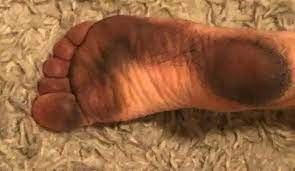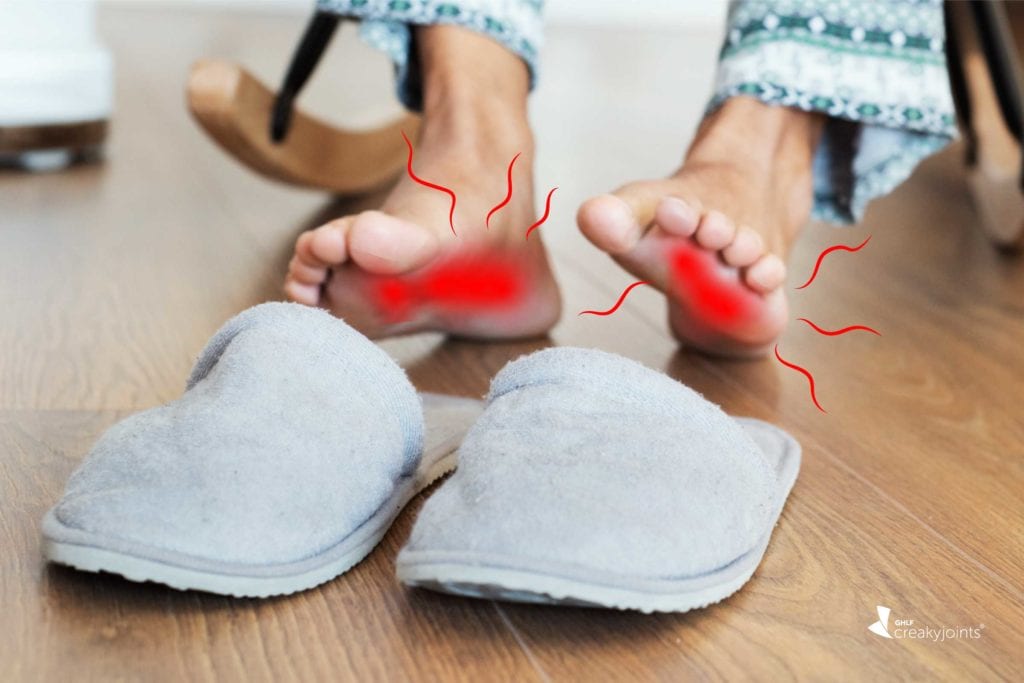Your floor might make your feet black due to the accumulation of dirt and dust particles on its surface. Walking barefoot on a floor that turns your feet black can be an annoying and frustrating experience.
The dark residue on your feet is usually caused by the buildup of dirt, dust, and other particles on the floor. These particles can stick to the bottom of your feet when you walk, giving your feet a black appearance.
Understanding why this happens can help you take the necessary steps to prevent it. We will explore the reasons behind why your floor makes your feet black and provide some tips on how to keep your floors clean and free from residue. So, let’s dive in and find out the causes and solutions to this common problem.

1. Common Culprits Causing Black Feet
Black feet can be an annoying problem that many homeowners experience, and there are several common culprits that can cause this issue. One possible cause is the sticky residue left behind from shoes. This residue can easily transfer onto the floor and leave a black mark. Another potential cause is worn-out carpet fibers. As carpets age and start to wear down, the fibers can break off and leave black particles on the floor. Lastly, accumulated dust and dirt can also contribute to black feet. Over time, dust and dirt can build up on the floor surface and create a black film.
2. Sticky Residue From Shoes
Having black feet after walking on a floor can be frustrating, but understanding the problem can help find a solution. One common reason why floors make feet black is due to sticky residue from shoes. Shoe soles can pick up various residues from surfaces they come into contact with, which then transfer to the floor and eventually onto your feet.
The best way to identify shoes with sticky soles is by examining the soles themselves. Look for any visible residue or stickiness on the bottom of your shoes. Additionally, if you notice that your shoes consistently leave marks on the floor, it may be an indication of sticky soles.
To minimize black feet, prevention is key. Here are some tips to help prevent shoe residue from causing this issue:
| 1. | Regularly clean the soles of your shoes and remove any built-up residue. |
| 2. | Avoid wearing shoes with sticky soles on floors that are susceptible to marks. |
| 3. | Consider using doormats or shoe cleaning stations near entrances to remove excess residues. |
| 4. | Use shoe protectors or covers when walking on floors that you want to keep clean. |
By following these prevention tips and being aware of shoes with sticky soles, you can reduce the chances of having black feet after walking on certain floors.
3. Worn-out Carpet Fibers
Have you ever wondered why your floor leaves your feet black? One possible culprit could be worn-out carpet fibers. Over time, carpets can become worn and damaged, leading to numerous problems, including the dreaded black feet. Worn-out carpet fibers can fray and break down, creating a buildup of dirt, dust, and debris that can discolor your feet when you walk on them. So, how can you spot worn-out carpets before it’s too late? Keep an eye out for signs of damage, such as tears, bald spots, or matting. Regularly inspect your carpets and address any issues promptly to prevent further wear and tear.
To prevent carpet-related black feet, a proactive approach is key. Implementing a regular cleaning routine is essential, including vacuuming and deep cleaning to remove dirt and debris. Consider using entrance mats to trap dirt before it reaches your carpet. Additionally, wearing clean socks or slippers indoors can minimize foot-to-floor contact and reduce the chances of black feet. By these simple preventive measures, you can maintain clean and vibrant carpets, allowing you and your family to enjoy a comfortable and foot-stain free living space.
4. Accumulated Dust And Dirt
Accumulated dust and dirt on your floor can contribute to black feet, leaving unsightly marks and potentially causing irritation. Dust and dirt act as abrasive particles that get stuck to your feet, creating a dark residue as you walk around your home. Additionally, dust and dirt can settle into the fibers of your carpet or floor covering, making it even harder to remove.
There are warning signs to look out for if you suspect your floor is accumulating dust and dirt. For example, if you notice that your floor appears dusty, even after regular cleaning, or if you constantly find yourself needing to sweep or vacuum, these may be indications of a build-up.
To avoid black feet caused by accumulated dust and dirt, it’s important to implement regular cleaning techniques. This includes sweeping or vacuuming your floors regularly to remove any loose debris, as well as mopping or steam cleaning to remove any remaining dirt.
In conclusion, accumulated dust and dirt can lead to black feet, creating both aesthetic and potential health concerns. Regular cleaning practices help prevent the build-up of dust and dirt, ensuring your floor remains clean and safe for your feet.
5. Additional Factors To Consider
There are a few additional factors to consider that may contribute to your floor making your feet black. One possible reason could be frequent outdoor activities. When you step outside, your shoes come in contact with various elements such as dirt, dust, and pollution. As you walk back indoors, these particles can get trapped on the bottom of your shoes and eventually transfer onto your floor, causing it to accumulate dirt and grime over time.
Poor indoor air quality can also play a role in this issue. If your home has inadequate ventilation or suffers from high humidity levels, it can create a favorable environment for mold and mildew growth. Once these fungi develop, they can release small spores into the air, which can settle on your floor and create a dark, dirty appearance.
Another cause may be unresolved mold or mildew issues. Even if you have cleaned your floor thoroughly, if you have an underlying mold or mildew problem, the discoloration may persist. It is essential to address any mold or mildew issues promptly to prevent further damage and ensure a clean living environment.
By considering these additional factors and taking appropriate steps to address them, you can minimize the occurrence of blackened feet and maintain a cleaner floor.
6. Prevention And Cleaning Tips For Black Feet
Learn how to prevent and clean black feet caused by your floor with these effective tips. Say goodbye to blackened feet and keep your floors clean and pristine.
Regular Shoe Cleaning Routine
To prevent black feet caused by dirty floors, it is important to establish a regular shoe cleaning routine. Start by wiping your shoes’ soles and edges with a damp cloth or disinfectant wipe before entering your home. This will help remove any dirt or residue that may be present. Additionally, consider having a designated area near the entrance of your home where you can remove your shoes and clean them thoroughly before entering further. This can be done using a shoe brush or by rinsing them under running water if they are washable. By making shoe cleaning a habit, you can significantly reduce the amount of dirt brought into your living spaces.
Vacuuming And Deep Cleaning Your Floors
Another important step in preventing black feet is to maintain a clean floor. Regular vacuuming can help remove dust, dirt, and debris that could accumulate and transfer to your feet. Pay special attention to corners, edges, and high-traffic areas. Additionally, deep cleaning your floors periodically is crucial, especially if they are prone to staining. Use a suitable floor cleaner or consult the manufacturer’s guidelines for the best approach. This will help eliminate any stubborn residue that may be causing black feet, leaving your floors cleaner and safer to walk on.
Professional Cleaning Services For Stubborn Black Feet
If despite your best efforts, black feet persist, it might be time to consider professional cleaning services. Professional cleaners have the expertise and specialized equipment to tackle stubborn stains and marks on floors effectively. They can provide deep cleaning treatments that go beyond regular maintenance. Consider scheduling a professional cleaning session to address any persistent black feet issues and restore the cleanliness and appearance of your floors.
Frequently Asked Questions On Why Does My Floor Make My Feet Black
Why Do My Feet Get So Dirty In The House?
Your feet get dirty in the house due to dust, dirt, and debris that gets tracked in. Regular sweeping, mopping, and using doormats can help reduce dirt from entering your home.
Why Are My Socks Dirty After Mopping?
Mopping can make socks dirty due to the friction between the wet mop and the floor’s dirt or grime. This can transfer onto your socks, leaving them dirty. To prevent this, wear slip-on shoe covers or use a mop with better absorbency.
Why Do I Get Black Feet?
Black feet can occur due to several reasons, such as poor blood circulation, bacterial or fungal infections, or excessive sweating. These factors can lead to the accumulation of dirt and dead skin on the feet, causing them to appear black.
Maintaining good foot hygiene and wearing breathable footwear can help prevent black feet.
Why Do My Feet Always Look Dirty?
Your feet may always look dirty due to variables like sweat, dirt buildup, or lack of proper cleaning.
Conclusion
After exploring the reasons behind why your floor makes your feet black, it is clear that several factors contribute to this frustrating problem. From dirt and dust buildup to the presence of certain chemicals, it’s essential to address these issues properly.
Regular cleaning, using appropriate cleaning products, and considering alternative flooring options can help alleviate this issue and ensure a clean and comfortable environment for you and your family.




